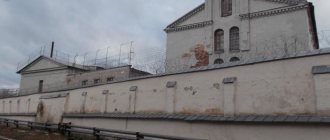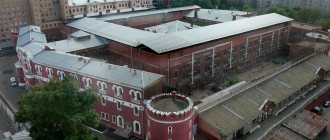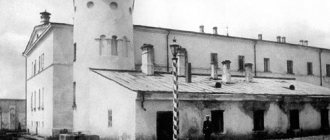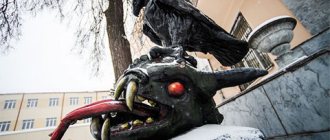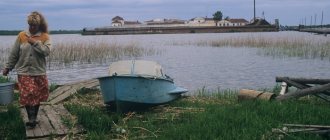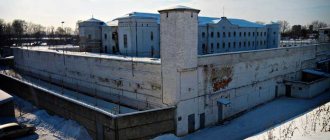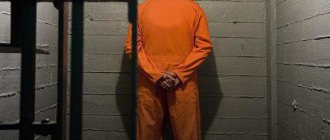Lenta.ru completes a series of publications about special regime colonies - the most terrible zones in Russia. There, the most dangerous criminals - from maniacs and cannibals to terrorists and leaders of criminal gangs - are serving life sentences there in extremely harsh conditions. In the previous article we talked about the Torbeevsky Central colony in Mordovia. This time we will talk about the Snezhinka colony in the Khabarovsk Territory - the newest zone for life prisoners. Its security system with motion sensors, surveillance cameras and retinal scanners is considered the most advanced in Russia. The jailers in Snezhinka don’t even really need service dogs—it’s basically impossible to escape from there. And the killers and maniacs sitting there can only complain about the roar of fighters from Komsomolsk-on-Amur, which prevents them from sleeping at night...
"A comfortable place for a person to live"
The name of the village of Elban in the Khabarovsk Territory in the language of the Ulchi, a small people living in the Lower Amur basin, means “a convenient place for a person to live.” Ironically, it is there that the first and only zone for life prisoners in the Far East is located - correctional colony No. 6 (IK-6). Elban was founded in the mid-30s of the 20th century, during the construction of the Volochaevka - Komsomolsk-on-Amur railway line. Construction work, as often happened at that time, was carried out by convicts from one of the Gulag units.
Quantity in the Russian Federation
How many prisons in Russia are there for life imprisonment? At the moment there are seven of them . They are located mainly in the European part of Russia.
Conditions in these prisons, although harsh, have improved significantly over the past 17 years.
In most life-sentence prisons in Russia, major and cosmetic repairs , new hospital buildings have been built, and there is an opportunity for prisoners to earn money.
Guests from "Black Golden Eagle"
The insulator received its unusual name - “Snowflake” - due to the fact that its buildings are arranged in the shape of a seven-pointed star. The pre-trial detention center was inaugurated at the end of January 2015, although it was put into operation back in 2012. “Snezhinka” operated as a detention center for only two years, and its occupancy rate with prisoners never exceeded eight percent of all places. As a result, they decided to repurpose the unused pre-trial detention center into IK-6, a special regime zone for those sentenced to life terms.
IK-6 "Snowflake"
Photo: Federal Penitentiary Service of Russia for the Khabarovsk Territory
Today “Snezhinka” is designed for 378 “life prisoners”, who can be accommodated in 144 cells; they are located in the second, third and fourth blocks of the zone. In fact, there are 250 life prisoners in IK-6. The first 23 of them arrived in Elban on September 20, 2021 - before that they were in the famous Black Golden Eagle colony in the Sverdlovsk region, which they decided to close.
The convicts were traveling in stages through the Irkutsk pre-trial detention center, and some of them, barely reaching Elban, hastened to write complaints about ill-treatment in the detention center. The prisoners were outraged that they were led around the territory of the Irkutsk detention center in handcuffs and with guard dogs. Those sentenced to life considered these measures unnecessary and even torture, because in the Black Golden Eagle they were distinguished by exemplary behavior. True, an audit carried out on the basis of complaints from convicts confirmed that all the security measures that were applied to prisoners in the pre-trial detention center were appropriate.
List of maximum security colonies in Russia
In addition, the most stringent conditions of detention act as an instrument of retribution for the crimes they have committed.
Prisoners in a maximum security prison are practically deprived of the opportunity to work and communicate with their neighbors in the colony; their walks are limited to an hour and a half in the inner prison courtyard. Important! Since in this case the goal is correction, there is practically no transfer to other, easier conditions of serving.
Thus, for those sentenced to life, the opportunity to transfer to regular conditions of a colony from prison is provided, at best, after ten years.
We recommend reading: The trademark certificate is valid
A strict regime is prescribed by the court for offenders who have committed especially serious crimes, but who have not previously been held in a colony.
Repeat offenders are also subject to being sent to a strict regime colony, but only in the absence of a dangerous or especially dangerous relapse.
Women are not sent to a maximum security colony, much less to a special regime.
Life sentence and no sweets
Each cell in Snezhinka is designed for four places, but so far there are only two people in them: there are not too many convicts in IK-6. Every day of prisoners is built according to a clear schedule: wake up at 6:00, bedtime at 22:00. Twice a week, prisoners can shower for 15 minutes. In their free time from work and walking, they can read, play chess or checkers, and also watch TV. Once a week, a movie show is held at Snezhinka.
Prisoners in IK-6 are fed three times a day; their diet consists of porridge, borscht, naval pasta, fish and stewed vegetables. Repeating the same dish is allowed no more than three times a week. Each prisoner in Snezhinka receives 90 grams of meat daily. Working in the kitchen and distributing food are 47 convicts convicted of petty crimes, who were specially brought to IK-6.
“Snezhinki” does not feed convicts sweets, but prisoners can order them themselves in the colony store. At the same time, each prisoner has a limit on purchases. For the first ten years of the term, it is a maximum of six thousand rubles, and then increases by another thousand. After 20 years behind bars, a convicted person can already spend 7.5 thousand rubles a month on purchases - of course, if he has this money.
Lunch at IK-6 “Snezhinka”: first course, two second courses and compote.
Photo: Evgeny Pereverzev / Kommersant
Two decades behind bars provide another privilege - additional visits with relatives. If until 20 years of imprisonment, each prisoner is entitled to two short-term and two long-term meetings per year, then after 20 years, convicts receive the right to three visits with loved ones for four hours and three meetings lasting up to three days.
However, all this is only due to those convicts whose behavior the prison administration has no complaints about. Violators may not only be denied visits, but also sent to a punishment cell (punishment cell) for up to 60 days, or even transferred to a particularly strict prison regime. Convicts can stay there for up to three years.
The cells for repeat offenders are special: instead of ordinary beds, prisoners sleep in them on not very comfortable sun loungers, which are removed during the day and fastened to the wall. The convicts there are not entitled to any parcels, visits, or watching TV. However, so far there has not been a single prisoner in Snezhinka who would be thrown into a punishment cell for violations.
Special regime prisons in Russia
Prisoners in a maximum security prison are practically deprived of the opportunity to work and communicate with their neighbors in the colony; their walks are limited to an hour and a half in the inner prison courtyard. In the intellectual sphere, recidivists are characterized by a lagging general educational and cultural level, limited socio-political knowledge, narrow views and interests, and a small amount of life experience in a socially useful field of activity.
Maximum security colonies in Russia list of videos If you look at the “Crosses” from the opposite bank of the Neva, it is difficult to recognize what opens up to your gaze - a complex of elegant red brick buildings, a church with three domes, a low fence and a tall chimney going into the sky - a place from series “Abandon hope, ye who enter here.” Nevertheless, this very bright place at first glance is one of the most tragic in St. Petersburg. Most often, a strict regime does not apply to the settlement as a whole, but to a separate category of citizens in the institution.
The zone where people recognize by their eyes
“Snezhinka” is distinguished from other special regime zones by the fact that there are few service dogs on its territory - Rottweilers, shepherd dogs and golden retrievers trained for drugs. There is simply no point in keeping a lot of them in Elban: along the perimeter of IK-6 there are ultra-sensitive motion sensors and numerous video surveillance cameras - there are more than a thousand of them in Snezhinka. Moreover, the camera lenses capture not only the territory of the zone, but also the village in which it is located. Data from surveillance devices is fed to monitors that are constantly monitored by prison guards.
There is an additional cage inside each Snezhinka cell, and guards in IK-6 are on duty on all floors without exception. It is virtually impossible to escape from there: to leave the territory of the zone, an electronic pass is not enough - the entrances and exits to the colonies are equipped with special equipment that scans the retinas of the jailers’ eyes. In addition, “Snowflake” is the most illuminated object in Elban, and the bright light makes every nook and cranny visible.
Screens of surveillance cameras of IK-6 “Snezhinka”
Photo: Evgeny Pereverzev / Kommersant
By the way, by prison standards, service in Snezhinka is quite prestigious: the salaries are high, and a year of work is counted as two. In addition, employees of IK-6 have the right to further training at the Kuzbass Institute of the Federal Penitentiary Service (FSIN) in Novokuznetsk. People often come to work for the zone in Elban from other settlements of the Far East, for which there is a dormitory on the territory of Snezhinka.
Due to the very high level of security in IK-6, prisoners are driven around the colony without handcuffs. However, such humane conditions are not appreciated by all “wads” - that’s what people sentenced to life are called in prison jargon. Some are dissatisfied with the remoteness of the colony: this makes it difficult for relatives to come for visits, and letters sometimes take a month or a month and a half to reach the addressee. By the way, all mail must be censored by jailers, because the likelihood that the letters will contain something forbidden is very high. Only letters from lawyers are not opened in IK-6.
And some prisoners in Snezhinka are not satisfied with the strict rule of this zone: all convicts are required to work, regardless of their desire. The colony has workplaces where prisoners do sewing and woodworking.
IR special regime in Russia list
2. FKU IK-3 - st. Polina Osipenko, 49, Vladimir. 3. FKU IK-2 - st. Eletskaya, 2, Livny.
4. FKU IK-6 - maximum security women's colony (1300 places) village. Shakhovo, Kromsky district. 5. FKU IK-10 “Vaskin Mokh” - village. Metallistov, p/o Mikhailovskoye, Kalininsky district. 6. FKU IK-19 - r.p. Markovo, Irkutsk district, Irkutsk region. 7. FKU IK-43 - st. Attention Bakh, 3a, Yagunovsky settlement, Kemerovo. 8. FKU IK-2 - st.
Tselinnaya, 50, Rybinsk, Yaroslavl region.
We recommend reading: Soy lecithin E476 benefit or harm
and many others. Most often these are remote areas of the city or populated areas. As a rule, the pre-trial detention center (pre-trial detention center), where the accused are kept during the investigation before sentencing, are located within the city. Colonial settlements are considered the most comfortable accommodation option.
You can get into such an institution for crimes of moderate and minor gravity and in the presence of mitigating circumstances. Convicts in colony settlements must adhere to the regime, work, have the opportunity to study and engage in self-education.
“At night I jump up in a cold sweat”
In 2021, one of the Snezhinka convicts, serving a life sentence for murder and theft, submitted a request to be transferred to Solikamsk IK-2 “White Swan”. In Elban, the prisoner was very annoyed by the fighters flying low over IK-6, which are produced at the plant in Komsomolsk-on-Amur.
Photo: Alexey Filippov / RIA Novosti
“I have great difficulty falling asleep and at night I shudder or jump up in a cold sweat. This is a consequence of the fact that fighter planes without silencers are flying very low [over the zone] in the village of Elban,” the inmate complained. And for some reason, with reproach to the employees of the local traffic police department, he added: “The traffic police inspectors do not fulfill their duties, like those who caught me on the highway when I removed the muffler from my bike.”
The prisoner managed to get his issue resolved. Moreover, the head of the airfield in Komsomolsk-on-Amur also gave a recommendation to listen to the convict’s complaints and transfer him to the “White Swan”. As a result, the prisoner was transferred to Solikamsk, although the reason for the transfer did not fall into the established list of significant reasons - illness, ensuring personal safety, or liquidation of a correctional institution.
Special regime colonies in Russia
In many prisons, where there are prisoners with different conditions of detention, separate blocks or buildings are reserved for especially dangerous criminals. How does such an institution differ from other places of detention? The main difference between a special regime prison and others lies in the purpose of keeping criminals in it.
If in other prisons, with a lighter regime, the goal is considered to be the re-education of those serving their sentences, then those who are not believed in the possibility of re-education are subject to a special regime. The purpose of their imprisonment is to protect other people from their attacks, as well as to punish them with harsh conditions for the crimes they have committed.
They cannot communicate with other prisoners, except with their cellmate (such prisoners are usually kept two to a cell).
Echoes of bloody showdowns
Each of those serving life sentences in Snowflake has a very dark past. For example, one of the oldest prisoners of IK-6, 75-year-old Stanislav Tishchenko, was previously imprisoned in the Black Dolphin colony in the Orenburg region. Tishchenko was there with his son Igor, and they ended up behind bars because of a gang war that occurred in 1996.
Then Igor Tishchenko opened fire at a kebab shop near Norilskaya Street in Moscow, and his father Stanislav threw a grenade at his opponents. Among those killed in the incident was thief in law Nikolai Akbashev, known in criminal circles as Akbashenok. For the attack in a kebab shop, father and son Tishchenko received life sentences.
Stanislav Tishchenko
Photo: Mzk1.ru
Stanislav Tishchenko’s neighbor in “Snezhinka” Alexander Lozhkin is a participant in the most mass murder in the Middle Urals. It was committed in one of the saunas of Nizhny Tagil on the night of February 8, 1997: a party was being held there on the occasion of the birthday of one of the vacationers. As usual, there was some alcohol involved, and at some point a quarrel broke out in the sauna. During the ceremony, the birthday boy asked four guests to leave, one of whom was Lozhkin.
He was offended by such a disrespectful gesture, took out a gas pistol, which he himself converted into a combat pistol, and began to shoot. The three remaining guests, who were asked to leave the sauna, attacked their opponents with knives. As a result, eight people died, six of whom were killed by Lozhkin. In 2001, he received a life sentence, which he served in the Black Golden Eagle before Snezhinka.
Federal state prison-type institutions
No. 1 Federal Penitentiary Service for the Vladimir Region
600120, Vladimir region, Petushinsky district, Pokrov, st. October Revolution, 75-A, tel.: 8 (49243) 6-72-70. General and strict regimes.
The prison was founded in 1822 as Pokrovsky Prison Castle. Later - Pokrovskaya transit prison. Initially it functioned as a medical and labor clinic. Since the early 1960s, a specialized prison for tuberculosis patients.
Convicts who are in prison and have tuberculosis are serving their sentences. Among the prisoners are dangerous criminals, repeat offenders from all over the country.
No. 2 in the Vladimir region (“Vladimir Central”)
600020, Vladimir region, Vladimir, st. Bolshaya Nizhegorodskaya, 67 tel. General and strict regimes.
Conditions of detention were tightened during the years of the first Russian revolution. There were frequent cases of attacks on employees, including the heads of detachments, fights between cellmates with sharpeners in their hands, and deaths of prisoners.
Founded in 1783 as a workhouse for those convicted of minor crimes. Since 1838 - a prison company. Since 1906, a temporary convict prison for political prisoners, immediately after the revolution - Vladgubispravdom, since the early 1920s - the Vladimir political detention center, then TON (special purpose prison).
They go to prison for serious or especially serious criminal acts. Famous prisoners: State Duma deputy Vasily Shulgin, who accepted the abdication of the throne from Nicholas II, singer Lidia Ruslanova, actress Zoya Fedorova, Vasily Stalin.
We invite you to watch a video about the Russian prison Vladimir Central:
FKU "Prison of the Federal Penitentiary Service of Russia in the Krasnoyarsk Territory"
662606, Krasnoyarsk region, Minusinsk, st. Gorky, 114 tel.: 8 (39132) 2-59-82. General and strict regimes.
Prisoners are “broken” through physical violence against them. There are also cases of death among those prisoners who were preparing for imminent release.
The Minusinsk prison was first mentioned in documents in October 1912. After the revolution it was called the county ITD, pre-trial detention center-2, in 1992-1999 - a pre-trial prison, and since January 2005 - a prison.
Particularly dangerous criminals are held. The crime boss Ruslan Gegechkori (Shlyapa Mladshiy), Aslan Cherkesov, and Chechen businessman from Khakassia Abdul Isaev served their sentences here.
No. 2 GUFSIN of Russia for the Krasnoyarsk Territory
663180, Krasnoyarsk region, Yeniseisk, st. Dekabristov, 11 tel.: 8 (391-95) 2-46-92. General and strict regimes.
In the 17th century, torture and executions were carried out here in a special courtyard, including by burning at the stake. In the 50s of the 20th century, death sentences passed by the court were also carried out here.
Initially, the prisoners lived in pits. In 1863-1865 - construction of a new stone building. Since the mid-1950s - a prison. Since August 1999, it has been accepting convicts from the prison regime. From 2005 to 2013 it functioned as a pre-trial detention center.
They hold life prisoners who have committed serious or especially serious crimes: child killers, terrorists, serial maniacs, even cannibals.
Archpriest Avvakum, leader of the Socialist Revolutionary Party Gershuni, Joseph Stalin (1913), and Archbishop Luka (Voino-Yasenetsky) served their sentences here.
FKU "Prison of the Federal Penitentiary Service of Russia in the Saratov Region"
412315, Saratov region, Balashov, st. Uralskaya, 17. Tel.: 8 (84545) 6-32-72. General and strict regimes.
In the 30s of the 20th century, executions were carried out in the Balashov prison under Art. 58. In the 1980s, there were frequent prison riots here, after which prisoners were severely beaten.
Established in 1837 as the Balashov district prison. The stone one-story building was built after a fire in a wooden structure. At the beginning of the 19th century, a new four-story stone building was built.
They are caught for especially serious crimes (robberies, robberies and murders) and in case of a particularly dangerous recidivism of the crime, as well as for violating the order by transferring from the penal colony. Pyotr Ionovich Yakir (historian, dissident) sat here.
FKU "Prison of the Federal Penitentiary Service of the Ulyanovsk Region"
433513, Ulyanovsk region, Dimitrovgrad, st. Kalugina, 66 tel.: 8 (84235) 9-34-61. General and strict regimes.
It has existed since 1896 as a house of arrest, after the revolution - the Melekessky district house of detention. Since 1937 - Prison No. 4, since 1964 - Pre-trial Detention Center No. 2, since 1987 - Prison. They go to prison for especially serious crimes. Among the prisoners are terrorists, thieves in law and gang leaders, active members of gangs and members of organized crime groups.
FKU "Prison of the Federal Penitentiary Service of Russia in the Chelyabinsk Region"
457670, Chelyabinsk region, Verkhneuralsk, st. Severnaya 1 tel.: +7 (35143) 2-13-98,. General and strict regimes.
The cruelties of the prison are associated with the legend of the royal punishment cell, which is located in the basements of this prison-fortress. The punishment cell is supposedly an endless labyrinth from which there is no way out. It was there that the most dangerous prisoners were sent, and they wandered here until their deaths.
Created in 1914. At different times the prison was closed and then reopened. In 1966, ITK-13 was created on the basis of the prison. In 1972 the prison was restored. Those who served their sentences were Zinoviev, Kamenev, Radek, the first editor of Komsomolskaya Pravda Slepkov, Hitler's sister M. Koppesteiner, diplomat Raoul Wallenberg, Fanny Kaplan, Metropolitan Krutitsky.
FKU “Prison No. 2 of the Federal Penitentiary Service of the Lipetsk Region” (“Eletskaya Krytka”)
399783, Yelets, st. Proletarskaya, 1B, tel.: +7 (47467) 7-18-47. General and strict regimes.
According to history, for the slightest guilt, prisoners were chained in solitary confinement for 1 day without food and in the dark.
Founded in 1763, a new building was built in 1830. The Yeletsk prison stood at a crossroads, from here convicts and political exiles were sent in stages.
Among the prisoners: revolutionary figure D.I. Svyatsky, political exiles Druzhinin, Kamenitsky, Chigirinsky, crime boss Tariel Oniani (Taro).
From Elban to Milan
Not inferior to Lozhkin in terms of the number of victims is another convict of Snezhinka, a resident of Novokuznetsk, Maxim Kiselev. In 2009, he, along with his partner Anastasia and their one-year-old daughter, arrived in the village of Orton to celebrate February 23 - Defender of the Fatherland Day, and at the same time meet the relatives of his chosen one.
On this occasion, Anastasia’s parents arranged a feast, which turned into a quarrel: the girl’s father began to scold Kiselev for beating Anastasia. In response to this, the enraged guest committed a terrible massacre in the house, not even sparing an eight-year-old boy. Kiselyov still places all the blame for his crime on counterfeit alcohol: he allegedly got drunk and suffered a memory loss, which is why he committed mass murder.
Photo: Evgeny Pereverzev / Kommersant
During his time in Black Golden Eagle, Kiselev became a “star” - he starred in the documentary film by Italian director Mark Franchetti “Condemned. Colony number 56." After this, the convict received letters from all over the world. One of them became fateful: Kiselev met an Italian woman named Serena, with whom he plans to tie the knot in the near future. Serena even agrees to move to Khabarovsk from Milan.
Together with Kiselev, while away his life in the village of Elban, former drug addict Dmitry Dilschneider, nicknamed Novosibirsk Raskolnikov, at whose hands five elderly residents of Novosibirsk died in 2007. He attacked pensioners for profit, killing them with a hammer and a screwdriver, after which he took away all the valuables and remaining pensions from the victims. Dilschneider tried to challenge his life sentence through the Supreme Court - however, unsuccessfully.
Vologda nickel
One of the most terrible prisons in Russia. Previously, after construction, the building was known as a monastery. During the revolution, “enemies of the revolution” were kept there. But today it is a special regime correctional facility where pedophiles and serial maniacs serve life sentences. The Vologda Pyatak is the last place of residence of convicts. There is no way out of this prison.
The cells are searched daily. After waking up and making the bed, prisoners are prohibited from even sitting on it for the entire day.
Many prisoners say that this place is cursed. Periodically, the souls of the people they killed and angels appear to them. Experts attribute this to the fact that this place was once the house of the Lord.
